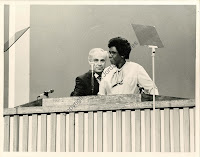 Part of
our mission at the Barbara Jordan Archives is to educate people about Jordan’s
life and legacy, but we also have an obligation to teach students, scholars and
the public at large about the value and necessity of archives as a way to
preserve our history and our culture.
And yes, archives are often are taken very seriously as repositories for bodies
of work and storehouses of knowledge.
But every now and then we have to remind ourselves of the more
lighthearted side of archival work.
What better time than the holiday season?
Part of
our mission at the Barbara Jordan Archives is to educate people about Jordan’s
life and legacy, but we also have an obligation to teach students, scholars and
the public at large about the value and necessity of archives as a way to
preserve our history and our culture.
And yes, archives are often are taken very seriously as repositories for bodies
of work and storehouses of knowledge.
But every now and then we have to remind ourselves of the more
lighthearted side of archival work.
What better time than the holiday season?
This year,
we thought it would be fun to find some holiday-themed materials in the Jordan
Archives. As Jordan was known for being
a private person in a public setting, finding these materials was not easy—but we
managed to find a few fun and interesting items that point not only to the busy
professional life of the Congresswoman, but how in demand her time was even
during the holiday seasons. Click here
to download the virtual exhibit (you will need Office PowerPoint 2007 or newer
to view the exhibit, or download PowerPoint Viewer here for free). Or, if you’re in the area, stop by and see
the actual exhibit at the Robert J. Terry Library through the end of December 2012.
Have a
wonderful holiday season from the Barbara Jordan Archives, TSU Special
Collections and the staff of the Robert J. Terry Library!

.JPG)












.jpg)
